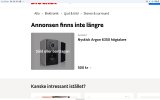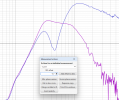Here are measurements of the Argon 6350 bookshelf speaker.
Argon speakers are developed and sold by the Danish retail chain Hifi Klubben (founded by Peter Lyngdorf). The retail price was ~131 USD/pair (1396 SEK) in 2014.

I measured at 10 deg increments both horizontal and vertical, using a calibrated UMIK-2 (1m).

The on-axis response is a bit uneven, but the early reflections are surprisingly smooth. Directivity error at crossover.




Horizontal directivity:

0-90 deg for comparison with Stereophile measurements:


Vertical directivity:



Distortion, 86 dB SPL at 1m (96 dB at 30 cm):


I didn't measure at higher SPL since it's not my speaker, and I want to return it in working order . There was no audible distortion or port noise though.
. There was no audible distortion or port noise though.
Overall, the results are quite impressive considering how inexpensive these speakers were. They were discontinued in 2018.
Argon speakers are developed and sold by the Danish retail chain Hifi Klubben (founded by Peter Lyngdorf). The retail price was ~131 USD/pair (1396 SEK) in 2014.
I measured at 10 deg increments both horizontal and vertical, using a calibrated UMIK-2 (1m).
The on-axis response is a bit uneven, but the early reflections are surprisingly smooth. Directivity error at crossover.
Horizontal directivity:
0-90 deg for comparison with Stereophile measurements:
Vertical directivity:
Distortion, 86 dB SPL at 1m (96 dB at 30 cm):
I didn't measure at higher SPL since it's not my speaker, and I want to return it in working order
Overall, the results are quite impressive considering how inexpensive these speakers were. They were discontinued in 2018.






